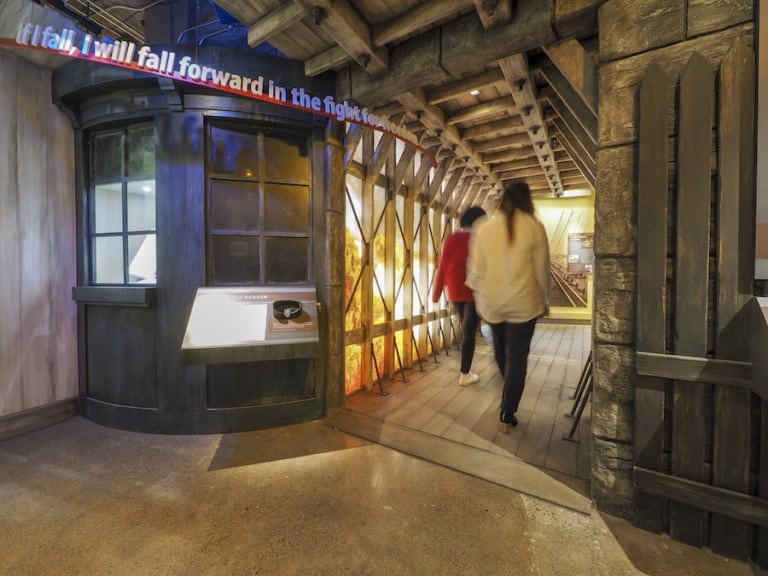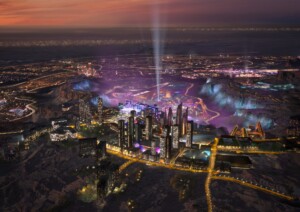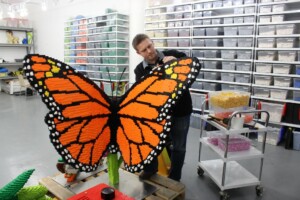Electrosonic, a leading international audiovisual and technology services company, has provided engineering and AV build services for the award-winning Niagara Falls Underground Heritage Center.
Electrosonic is pleased to announce that it has worked on a project with the award-winning Niagara Falls Underground Railroad Heritage Center, a popular visitor attraction which highlights authentic stories of Underground Railroad freedom seekers and abolitionists as they made their way to freedom in Canada.
The museum features a permanent exhibition entitled One More River to Cross which presents accurate recreations of these stories, alongside interactive media that immerses guests in the narrative. The exhibit shows the crucial role that Niagara Falls played in the Underground Railroad. The Center is inside the city’s iconic 1860’s customs house, adjacent to the Niagara Falls Amtrak station.
One More River to Cross won the 2019 Award of Excellence from The American Association for State and Local History.
A unique venue
“The intersection of Niagara Falls and the Underground Railroad presented us with a lot of unique scenarios that can’t be found anywhere else,” says Seth Frankel, Principal at Studio Tectonic in Boulder, Colorado.
“The Falls was one of the seven natural wonders of the world, the city was full of tourists, it was the industrial Silicon Valley of its day, and it was the narrow end of the funnel in the 40-year history of the Underground Railroad. Our goal was not to tell the history of the entire Underground Railroad, but rather to show the pathways that led to Niagara Falls and tell the very personal journeys of the freedom seekers.”
This project uses technology to bring this key 19th-century movement to live and to help visitors understand the story. This is done through linear video as well as interactive and interpretive media, which recreate the final stages of the gruelling journey. Multimedia recreations of the crossing points illustrate how dangerous the journey to freedom was. The exhibition also includes powerful audio, with historic figures telling their own stories.
Recreating the journey
Electrosonic provided engineering and AV build services, teaming up with exhibit fabricators United Service Associates, Inc as well as the lead exhibition design and interpretive firm Studio Tectonic and media developer Richard Lewis Media Group.
A visit to the Center takes guests on a journey through a series of gallery spaces, starting in the atrium of the Niagara Falls Amtrak station which is connected to the museum. Firstly, an interactive Network Wall shows the network of people and routes on the Underground Railway, using powerful imagery to explain the long journey from the American South to Buffalo, New York.
“The touchscreen interactive and the station’s stone wall used as a projection surface introduce the players: the freedom seekers, the hotel owners in Niagara Falls, the bounty hunters, bystanders,” says Frankel. “One hundred beautiful original watercolours commissioned from African American illustrator E.B. Lewis became stills and animations on the wall.”
Following on from this, visitors then enter the historic customs house, where they are transported to the 1850s. Here they can meet characters, interact with the setting, and witness scenes that explain these people’s roles in the Underground Railroad.
Next, visitors enter a recreation of the Cataract House hotel, complete with an interactive, page-turning registry. The hotel’s luxurious dining room is home to an interactive table, where visitors hear the sounds of dinner being served, alongside projections of the black free waiters who were secretly helping freedom seekers cross the border.
Stories of escape
The next part of the tour takes visitors through to the Escape Gallery, where the crossing stories of three people are narrated by actor Keith David. They can also meet key resistance figures like Harriet Tubman and Frederick Douglass. The wooden-boarded wall features projected lyrics from music sung by Mahalia Jackson, referring to Moses crossing into freedomland.
Then, a scale model of a section of the bridge shows visitors what that last crossing would have been like. “The actual bridge was the world’s first railroad suspension bridge,” says Frankel. “There’s a giant backlit historical painting of the Falls as they would have been seen by freedom seekers making the crossing, and there’s a projected line marking the US-Canada border – slavery and freedom. At the end of the bridge are windows framing the real location outside the building.”
Finally, guests enter the Freedom Gallery. This is a modern space with images of freedom seekers fro the 1870s to the present day, showing how people around the world are still fighting for liberty.
“The historical characters handoff visitors to modern-day individuals with their own stories to tell,” Frankel explains. “Visitors are invited to consider parallels between the historical and contemporary stories with the hope that these stories and connections will allow for deeper thought and consideration of different perspectives and prompt actions in our own lives.”
Audio and video solutions
The audio and video solutions provided by Electrosonic were tailored to the needs of each individual gallery. The team installed several touch and viewing monitors, ultra-short-throw, LED and DLP projectors and HD media players as well as expanded network I/O and audio support throughout. In addition to this Electrosonic also designed the overall control system. Rick Nelson was the Project Manager and Elliot Nyfield was the Engineer.
“It was our first time working with Electrosonic,” says Frankel. “We had a significant amount of media to put in a small space, and, as landmark building, it was a difficult space to work with. The Electrosonic team was instrumental in confirming that what we wanted to do could be accomplished and developed practical solutions to make our ideas a reality. We relied on them to turn our concepts into buildable, deliverable results.”
“This was an important project for Electrosonic in terms of its subject matter and the great working relationship we had with our partners, which really showed itself in the end result,” says Chris Johnson, Strategic Partner Manager at Electrosonic, Inc. “We formed a great team.”
“I remain impressed by how well the Center delivers its message and its mission,” adds Bryan Abelowitz, CTS-D, Director of Sales/East for Electrosonic Inc. “I am sure that most visitors leave with permanent impressions of this time in the nation’s history and a better understanding of the difficult subject matter.”
Last year, Electrosonic was honoured with a 2019 Commercial Integrator Integration Award in the Best Museum Project category, for its work on the 22,000-square-metre Sheikh Abdullah al Salem Cultural Centre (SAASCC) in Kuwait, the largest museum project in the world.
All images kind courtesy of Studio Tectonic



















